The Color, Blue
February 9, 2015
Because of my
Italian ancestry, my
veins are not that visible beneath my dark
skin. However, fair-skinned people have visible veins, and that's apparently where we get the term, "blue blood," to denote
aristocracy. Today, however, the skin of the average
one-percenter has become somewhat darker, so "blue-blood" is destined to become an
archaic term.
The color,
blue, is used to signify a
melancholy mood, and the word appears often in
popular culture. The following is a list of a few popular
songs with blue in their titles. I selected ones that are most familiar to me, and I played many of these in my short,
pre-scientific,
career as a
top-40 DJ.
One look through a
window will confirm that half our visible world is blue, at least on the nicer days.
Artists and
artisans have added blue to their
palette through the use of several
natural pigments. The most
historically famous of these is
ultramarine (Na
8-10Al
6Si
6O
24S
2-4), first obtained by
grinding the
mineral,
lapis lazuli. Lapis lazuli was imported into
Renaissance Europe from
Afghanistan, so ultramarine was expensive until its
chemical synthesis in 1826.
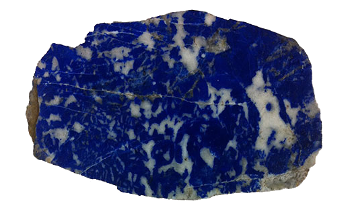
Lapis lazuli was first mined in Afghanistan, circa 4500 B.C.[1]
(Northwestern University image.)
Azurite, another blue pigment, is chemically
Cu3(
CO3)
2(
OH)
2. Azurite has been known since antiquity, and it's mentioned in
Pliny the Elder's Natural History.[2] Our word, "
cyan," comes from the
Greek word for azurite, κυανος (kyanos). I've often mentioned Pliny's Natural History.
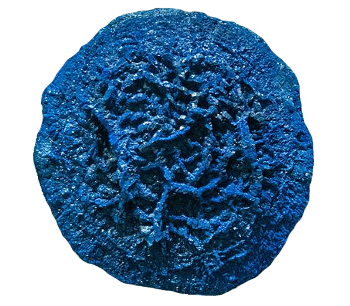
Azurite specimen in the Melbourne Museum.
(Photo by Graeme Churchard, cropped, via Wikimedia Commons.)
Egyptian blue is calcium copper
silicate (
CaCu
Si4O10). Unlike both ultramarine and azurite, it doesn't exist as a mineral. This first synthetically-produced pigment, known by the
Latin name, caeruleum, was produced in
Egypt, circa 2500
B.C. It's formed by the high
temperature reaction of
malachite (
copper carbonate hydroxide, Cu
2CO
3(OH)
2),
quartz (SiO
2), and
calcite (CaCO
3); viz.,
Cu2CO3(OH)2 + 8SiO2 + CaCO3 -> CaCuSi4O10 + 3CO2 + H2O
Often, a small quantity of
sodium carbonate was added to aid in the
fusion of the
reactants.
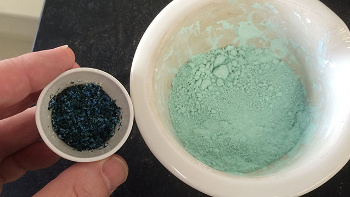
Laboratory synthesis of Egyptian blue pigment by firing sodium carbonate, quartz, malachite and calcite (right).
(Northwestern University image.)
As its
chemical formula indicates,
Prussian blue, Fe
7(CN)
18, is an inexpensive blue pigment. This chemical was the blue in the now rare
blueprints (cyanotypes), and it was also one chemical used in
laundry bluing before the current era of
optical brighteners (a.k.a., whiteners). Prussian blue is widely used in
dyeing, and in the
manufacture of
inks and other artist's colorants.
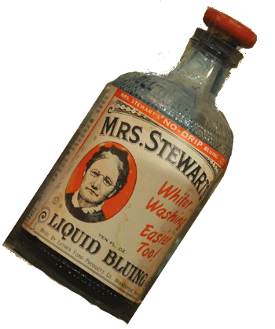
Mrs. Stewart's Bluing, first produced in 1883, was a fabric bluing agent made with Prussian blue.
I remember doing chemistry experiments with my mother's laundry bluing in the 1960s.
(Photo by Joe Mabel (modified), via Wikimedia Commons.)
One chemical stocked in my
childhood chemistry set was
cobalt (II) chloride (
CoCl2·6
H2O). Today, this chemical would not be sold to
children, since it's an
allergen, but it has a blue color in its
anhydrous form. The transition between its
hydrous (red) and anhydrous (blue) forms allowed its use as an inexpensive
humidity indicator. This one example illustrates the possibility that other cobalt (II)
compounds would have a blue color.
And Lo! (I must be channeling Pliny the Elder, here), there are
Cobalt blue, which is cobalt(II) aluminate, CoAl
2O
4, and also
Cerulean blue, which is cobalt(II) stannate, Co
2SnO
4.
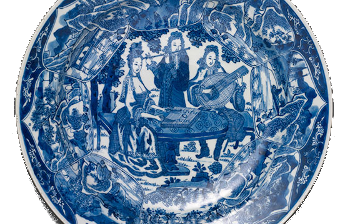
Cobalt blue dish, Europeans Playing Musical Instruments, Qing dynasty, Kangxi period (1661-1722).
(The Art Institute of Chicago, Bequest of Henry C. Schwab, via Northwestern University.)
Han blue,
BaCuSi
4O
10, also called,
Chinese blue, was used in
China from about 1000 B.C. Han blue was only discovered in a mineral form, effenbergerite, in 1993. It has always been synthesized from chemical reactants; for example, a fusion of
malachite ( copper carbonate hydroxide, quartz), and
barium carbonate.
Cu2CO3(OH)2 + 8SiO2 + 2BaCO3 -> 2BaCuSi4O10 + 3CO2 + H2O
You can see that this is the
barium analog of the Egyptian blue reaction, using barium carbonate instead of calcium carbonate.
Marc Walton, a senior scientist at the
Northwestern University,
Art Institute of Chicago,
Center for Scientific Studies in the Arts, has been intrigued by blue pigments for the past fifteen years.[1] It started when Walton, as a
graduate student, found that the word, "blue," didn't appear until
centuries after the first blue pigment, Egyptian blue, appeared.[1] Blue has a special place in pigments, since the color appears often in nature, but it doesn't appear that often in minerals.[1]
The Egyptians made extensive use of blue, but
Roman art used very little blue; so, the art of manufacturing blue pigment was lost.[1] Around the
6th century A.D., only lapis lazuli was used as a blue pigment, but it was used sparingly because of its cost.[1] Azurite became a cheaper blue pigment, and it was generally used as a foundation layer for the more vibrant lapis lazuli pigment. In modern times, Prussian blue was used by
Picasso, and
synthetic chemistry has given us many blue pigment alternatives.[1]
References:
- Megan Fellman, "Who Knew There Was so Much to Blue? - Scientist studies blue's invention and reinvention throughout history," Northwestern University Press Release, November 5, 2014.
- The Natural History of Pliny, John Bostock and H.T. Riley, Trans., (H. G. Bohn: New York, 1857), vol. 6, chap. 57 (via Google Books).
Permanent Link to this article
Linked Keywords: Italy; Italian; ancestor; ancestry; vein; skin; nobility; aristocracy; one-percenter; archaic; blue; depression; melancholy mood; popular culture; song; science; scientific; career; top-40 DJ; Tony Bennett; Blue Velvet; David Bowie; Blue Jean; Neil Diamond; Song Sung Blue; The Doors; Roadhouse Blues; Bob Dylan; Subterranean Homesick Blues; Tangled Up In Blue; Johnny Cash; Folsom Prison Blues; Crosby, Stills, & Nash; Suite: Judy Blue Eyes; Fats Domino; My Blue Heaven; Foreigner; Blue Morning, Blue Day; Tommy James and the Shondells; Crystal Blue Persuasion; The Marcels; Blue Moon; Roy Orbison; Blue Bayou; Carl Perkins; Blue Suede Shoes; Elvis Presley; Linda Rondstat; Bobby Vinton; Blue Velvet; The Who; Behind Blue Eyes; window; artist; artisan; palette; natural pigment; history; historical; ultramarine; grinding; mineral; lapis lazuli; Renaissance Europe; Afghanistan; chemical synthesis; Azurite; copper; carbonate; CO3; hydroxide; OH; Pliny the Elder; Natural History; cyan; Greek language; Melbourne Museum; Graeme Churchard; Wikimedia Commons; Egyptian blue; silicate; calcium; Ca; Silicon; Si; Oxygen; O; Latin; Egypt; Anno Domini; B.C.; temperature; chemical reaction; malachite; quartz; calcite; sodium carbonate; melting; fusion; reagent; reactant; laboratory; chemical synthesis; chemical formula; Prussian blue; blueprint; cyanotype; laundry bluing; optical brightener; dyeing; manufacturing; manufacture; ink; Mrs. Stewart's Bluing; experiment; mother; 1960s; Joe Mabel; childhood; chemistry set; cobalt (II) chloride; cobalt; Co; chlorine; Cl; water; H2O; child; children; allergen; anhydrous; hydrate; hydrous; humidity indicator; chemical compound; Cobalt blue; Cerulean blue; dish; Qing dynasty; Kangxi period (1661-1722); Han blue; barium; Ba; Chinese; China; barium carbonate; analogy; analog; Marc Walton; Northwestern University; Art Institute of Chicago; Center for Scientific Studies in the Arts; graduate student; century; Roman Empire; 6th century A.D.; Pablo Picasso; synthetic chemistry.